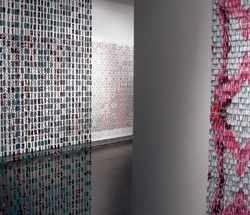Mark Cottle
From his Colony Square terrace, architect and artist Mark Cottle overlooks the lay of the land in midtown Atlanta with a unique perspective. Both a builder and designer, he assesses the urban environment from several viewpoints, musing on whether one could incorporate roof gardens atop the neighboring apartments to improve his view. Like many architects, Cottle wears several hats, moving among the commercial, academic and visual art worlds with equal aplomb.
Currently associate professor in the College of Architecture at Georgia Tech, where he was awarded tenure last year, Cottle is as comfortable speaking about his seminar on architectural detail as he is discussing the most challenging art exhibitions in the New York galleries. Many restaurant-going Atlantans appreciate his wonderful design work at The Globe at Tech Square, while the community of younger artists knows him as a portfolio reviewer for The Atlanta Contemporary Art Center’s open review days. The jewel in Cottle’s crown this season, however, was the recent summer exhibition of his art at the Georgia State University Welch Gallery as part of a two-person exhibition, On the Surface, with fellow architect Amy Landesberg.
For that show, Cottle produced two series of works from ephemeral materials designed as part of the visual grammar of the gallery space, as well as individual objects to be reckoned with. Paramount to his vision is the notion of the decorative in art, taken both from an academic and more quotidian/earthbound point of view. The first was a collection of bead curtains titled love_box, each created from mass-produced printed cards found on airplanes containing airport codes or safety instructions. They were constructed from folded “tiles” of paper vertically connected by paperclips, hung either flush to the wall as a wall covering or suspended as a space divider. Based upon shop curtains Cottle saw during travels through India, this humble architectural element becomes a vehicle for the artist’s cultural commentary. By knitting together simple materials, Cottle created tessellated abstractions, obscured images which read as both pattern and form in the space.
A second series of overlapping geometric patterns, digitally drawn and printed, were fixed directly to the wall with map pins, engulfing the viewer in an enormous maze of baroque movement in pale blues, pinks and black lines intersecting playfully from floor to ceiling. With the simplest means, Cottle produced a work rich in association, from modern maps to latticed walls to Islamic tapestries.
Cottle is working on a book about color in architecture and producing an exhibition in Paris for an architectural conference that will consist of videos of five international architectural firms. Working alongside a team of Atlanta-based video artists, including Sarah Hornbacher, Cottle hopes to bring this installation to Atlanta late next year.










